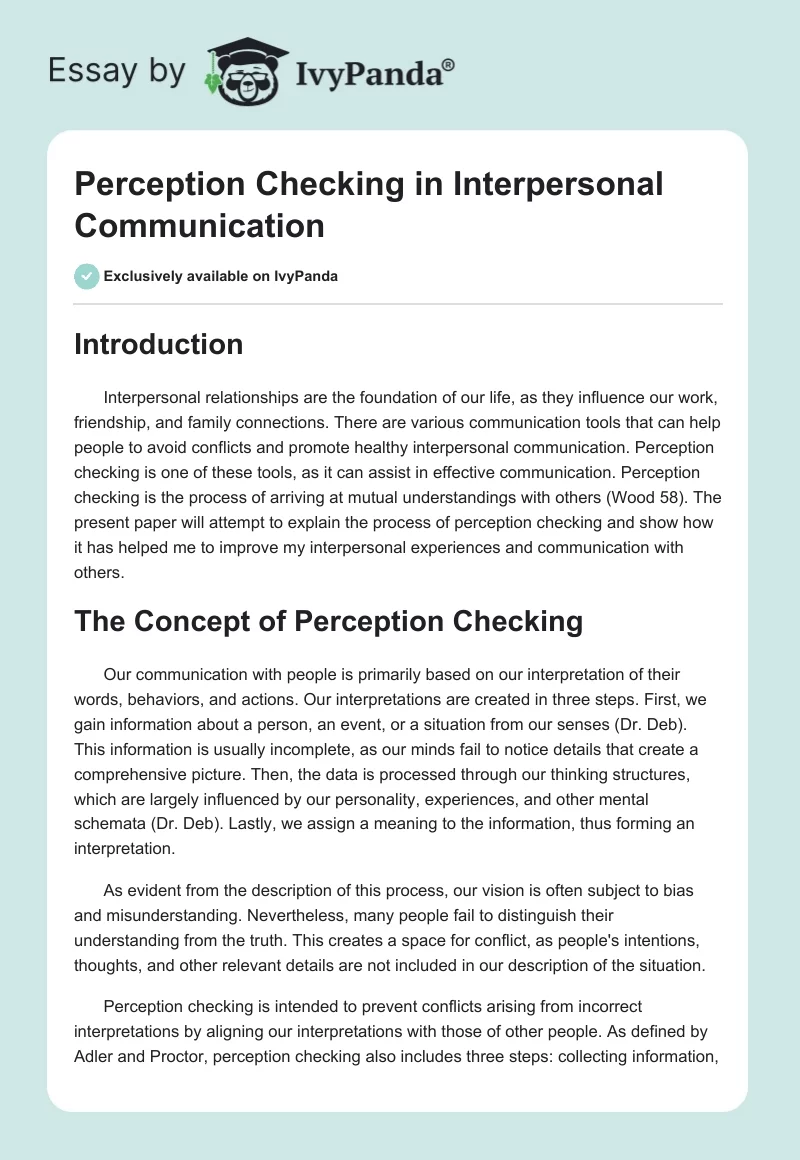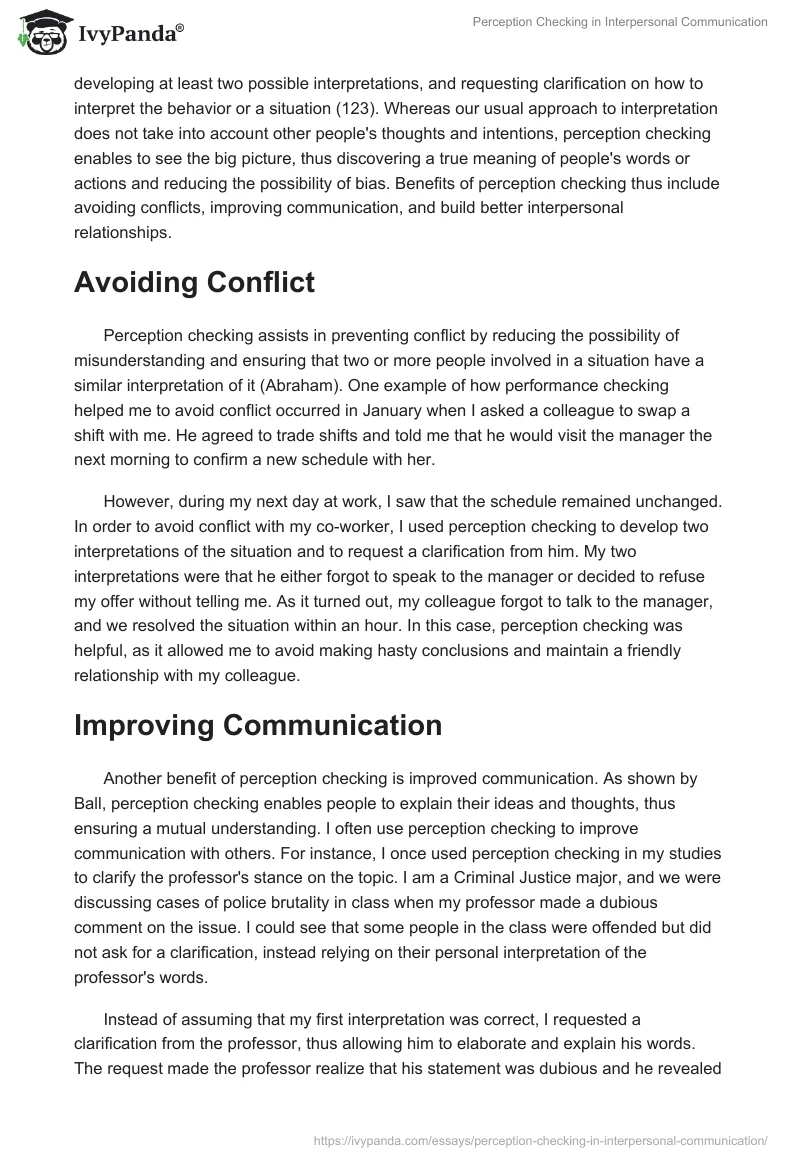Introduction
Interpersonal relationships are the foundation of our life, as they influence our work, friendship, and family connections. There are various communication tools that can help people to avoid conflicts and promote healthy interpersonal communication. Perception checking is one of these tools, as it can assist in effective communication. Perception checking is the process of arriving at mutual understandings with others (Wood 58). The present paper will attempt to explain the process of perception checking and show how it has helped me to improve my interpersonal experiences and communication with others.
The Concept of Perception Checking
Our communication with people is primarily based on our interpretation of their words, behaviors, and actions. Our interpretations are created in three steps. First, we gain information about a person, an event, or a situation from our senses (Dr. Deb). This information is usually incomplete, as our minds fail to notice details that create a comprehensive picture. Then, the data is processed through our thinking structures, which are largely influenced by our personality, experiences, and other mental schemata (Dr. Deb). Lastly, we assign a meaning to the information, thus forming an interpretation.
As evident from the description of this process, our vision is often subject to bias and misunderstanding. Nevertheless, many people fail to distinguish their understanding from the truth. This creates a space for conflict, as people’s intentions, thoughts, and other relevant details are not included in our description of the situation.
Perception checking is intended to prevent conflicts arising from incorrect interpretations by aligning our interpretations with those of other people. As defined by Adler and Proctor, perception checking also includes three steps: collecting information, developing at least two possible interpretations, and requesting clarification on how to interpret the behavior or a situation (123). Whereas our usual approach to interpretation does not take into account other people’s thoughts and intentions, perception checking enables to see the big picture, thus discovering a true meaning of people’s words or actions and reducing the possibility of bias. Benefits of perception checking thus include avoiding conflicts, improving communication, and build better interpersonal relationships.
Avoiding Conflict
Perception checking assists in preventing conflict by reducing the possibility of misunderstanding and ensuring that two or more people involved in a situation have a similar interpretation of it (Abraham). One example of how performance checking helped me to avoid conflict occurred in January when I asked a colleague to swap a shift with me. He agreed to trade shifts and told me that he would visit the manager the next morning to confirm a new schedule with her.
However, during my next day at work, I saw that the schedule remained unchanged. In order to avoid conflict with my co-worker, I used perception checking to develop two interpretations of the situation and to request a clarification from him. My two interpretations were that he either forgot to speak to the manager or decided to refuse my offer without telling me. As it turned out, my colleague forgot to talk to the manager, and we resolved the situation within an hour. In this case, perception checking was helpful, as it allowed me to avoid making hasty conclusions and maintain a friendly relationship with my colleague.
Improving Communication
Another benefit of perception checking is improved communication. As shown by Ball, perception checking enables people to explain their ideas and thoughts, thus ensuring a mutual understanding. I often use perception checking to improve communication with others. For instance, I once used perception checking in my studies to clarify the professor’s stance on the topic. I am a Criminal Justice major, and we were discussing cases of police brutality in class when my professor made a dubious comment on the issue. I could see that some people in the class were offended but did not ask for a clarification, instead relying on their personal interpretation of the professor’s words.
Instead of assuming that my first interpretation was correct, I requested a clarification from the professor, thus allowing him to elaborate and explain his words. The request made the professor realize that his statement was dubious and he revealed its true meaning to the class, thus easing the tension and clarifying what the correct interpretation was. There were two positive outcomes of using perception checking in this situation. Firstly, the professor appreciated my question and thanked me for giving him a chance to explain his words. Secondly, it showed the group that their first interpretation was incorrect, thus restoring the professor’s positive image in their minds.
Building Interpersonal Relationships
Lastly, perception checking aids in building healthy relationships with others, as it improves one’s ability to listen to and understand others (Nicksic). Therefore, it makes the people involved in the dialogue to feel appreciated and supported rather than ignored. One time when this tool helped me to better understand a person occurred when I was talking to a friend on the phone. I believed that he was disengaged from the conversation, as his responses were short and snappy. At first, I thought that my friend did not want to talk to me and was not interested in our discussion. I was about to end the call when I decided to apply perception checking.
I found two other possible interpretations of this behavior and asked my friend about his perception of the situation. My friend admitted that he just had a fight with his family and was not in the mood to chat with me but still wanted to help. Instead of cutting the call short, I listened to my friend’s story and offered him my advice and support, thus contributing to our relationship. Therefore, in this situation, perception checking proved to be a relevant and beneficial tool.
Critique of Perception Checking
Although perception checking applies to a variety of situations and contexts, there are some limitations associated with the method. As stated by Adler and Proctor, it is not applicable to some cultural context and may appear too blunt to people from Latin American or Asian cultures (125). Besides, perception checking may not be helpful in online or text communication. Adler and Proctor mention that a perception check is only effective if there is nonverbal congruency, i.e., if the person’s body language and voice convey openness and lack of accusation (124). In the contexts where the people cannot see or hear each other, perception checking could be taken for an accusation and have an opposite effect on the situation, triggering further misunderstanding and facilitating conflict.
Conclusion
Overall, perception checking can be a powerful tool for facilitating interpersonal relationships if used appropriately. In my personal life, perception checking has helped me to avoid conflict and improve my relationships with other people. The examples of perception checking offered in the paper show that this tool can help in promoting understanding, mutual respect, and dialogue between the parties, which is why I intend to continue using it in my work and personal life.
Works Cited
Abraham, Lauren. “The Power of Perception Checking.” Grand Canyon University. 2017. Web.
Adler, Ronald, and Russell F. Proctor II. Looking out, Looking in. Nelson Education, 2015.
Ball, Dana. “3 Reasons Why All Leaders Should Engage in Perception Checking.” Dana Ball Legal Services, 2018. Web.
Dr. Deb. “Perception Checking.” Get Control of Your Life. 2017. Web.
Wood, Julia T. Communication Mosaics: An Introduction to the Field of Communication. Cengage Learning, 2013.


